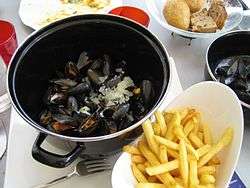Moules-frites
|
Moules, served in the pan, with fries. | |
| Alternative names | Mosselen-friet (Dutch) |
|---|---|
| Course | Main course |
| Place of origin | Belgium |
| Main ingredients | Potatoes, Mussels |
|
| |
Moules-frites or Moules et frites[1] (French pronunciation: [mul.fʁit]]; Dutch: mosselen-friet) is a popular main dish of mussels and fries originating in Belgium. It is also popular in France and in the rest of Northern Europe.[2] The title of the dish is French, Moules meaning mussels and frites fries, with the Dutch name for the dish meaning the same. It is sometimes considered the national dish of Belgium.[3]
The portion of moules in Belgian restaurants tends to be one and a half kilograms per person, which can be prepared in several different ways.
History
Although moules-frites are popular in France and around the world, it is thought that the dish originated in Belgium.[4] It is likely that it was originally created by combining mussels, a popular and cheap foodstuff eaten around the Flemish coast, and fried potatoes which were commonly eaten around the country in winter when no fish or other food was available.[4] On their own, french fries are also closely associated with Belgian cuisine by many Europeans.[5] Although Belgium claims to be the birthplace of french fries, their origin is uncertain and several other countries also claim the title.[5]
Variants and preparation
Moules
The ways in which the mussels are cooked in the dish can vary significantly. Some variants commonly seen are:
- Moules marinière: Probably the most common and internationally recognisable recipe,[6] Moules marinière includes white wine, shallots, parsley and butter to cook the mussels.[7]
- Moules natures: The mussels are steamed with celery, leeks and butter.[2]
- Moules à la crème: Another common recipe, where the white wine stock is thickened with flour and cream.[2]
- Moules parquées: A dish, probably originating in Brussels, of raw mussels on half a shell, served with a lemon-mustard sauce.
- Moules à la bière: In this recipe, the mussels are cooked in a sauce containing beer, instead of white wine.[8]
- Moules à l'ail: The mussels are cooked with sliced or minced garlic.[2]
Less commonly, fusion variants are seen in which the stock may be flavoured with non-local ingredients such as Espelette pepper or Pernod liqure.[2] They can also be served with "Mosselsaus", a sauce that is made with mayonnaise, mustard and vinegar. In Belgium, the moules used are generally farmed in nearby Zeeland in the Netherlands.[9]
Frites
In various forms, frites or friet play an important role in Belgian culture and cuisine. Within Belgium, bintje potatoes are generally preferred as a basis to make fries because of their high starch content.[5][2] They are generally double-fried (fried, left to cool and then fried again) in order to make them both moist in the core and crispy on the outside.[5] As a part of this, they are often fried at a particularly high temperature (around 190 °C (374 °F) ).[10]
Presentation and nutrition
As a dish, the moules and the frites are usually served on separate plates or dishes so that the fries do not become moist. Often, the moules are served in the same pan and stock used to cook them.[11] A second pan or dish is generally also provided in which the mussels' shells can be left once the mussels themselves have been eaten.
According to a French nutritionist, the optimum quantity of mussels is one litre, considering their nutritional value and Omega 3 content, but not more than 150 grams (5.3 oz) of fries.[12] This quantity contains between 500-600 calories.[12]
Popularity and in popular culture
In both Belgium and France, moules-frites are available in most restaurants. According to a survey conducted by TNS, moules-frites was identified as the second favourite dish in France, receiving a vote of 20 percent, narrowly losing to magret de canard which received 21 percent.[13] On average, between 25 and 30 tonnes of moules are consumed each year in Belgium as moules-frites.[14]
The Belgian musician, Stromae, performed a song entitled "Moules frites" in his 2013 album, Racine Carrée.
See also
References
- ↑ Spoiden 2001, p. 162.
- 1 2 3 4 5 6 Saveur 2011.
- ↑ Spoiden 2001, p. 169.
- 1 2 "Culinary Encyclopedia: Moules-frites". www.ifood.tv. Retrieved 2 December 2012.
- 1 2 3 4 Spoiden 2001, p. 166.
- ↑ Visit Belgium.
- ↑ BBC Food.
- ↑ "Belgium: Moules-frites". Where the food is. Retrieved 13 November 2012.
- ↑ Spoiden 2001, p. 168.
- ↑ Spoiden 2001, p. 167.
- ↑ Spoiden 2001, p. 159.
- 1 2 La Voix du Nord 2010.
- ↑ Doctissimo 2011.
- ↑ RTL 2011.
Bibliography
- Coenart, Virginie (14 July 2011). "A nous les moules-frites!". RTL. Retrieved 13 August 2014.
- "Le magret de canard, plat préféré des Français, devant les moules-frites". Les News Nutrition (in French). Doctissimo. Retrieved 2 December 2012.
- Malgieri, Nick (18 May 2011). "A National Obsession: Belgium's Moules Frites". Saveur. Retrieved 13 November 2012.
- "Mussels". Visit Belgium. Retrieved 13 November 2012.
- Spoiden, Stéphane (2001). "The Betrayal of Moules-frites". In Schehr, Lawrence R.; Weiss, Allen S. French Food: On the Table, On the Page, and in French Culture. New York: Routledge. ISBN 978-0415936286.
- Thompson, Antony Worrall. "Moules marinière". BBC Food. Retrieved 13 November 2012.
- "Qui peut faire la peau à la "moules-frites"?". La Voix du Nord (in French). 5 September 2010. Retrieved 13 November 2012.
External links
| Wikimedia Commons has media related to Moules-frites. |
